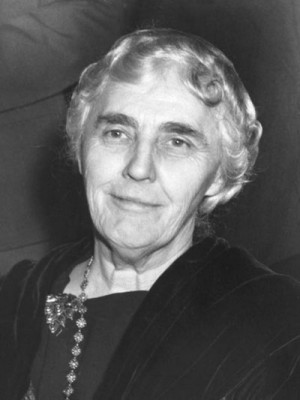Lou Henry Hoover (Lou Henry Hoover)

Lou Henry Hoover
Lou Henry was born in Waterloo, Iowa, to banker Charles Delano Henry and Florence Ida Weed. Lou grew up something of a tomboy in Waterloo, as well as Whittier, California, and Monterey, California. Charles Henry took his daughter on camping trips in the hills—her greatest pleasures in her early teens. Lou became a fine horsewoman; she hunted, and preserved specimens with the skill of a taxidermist; she developed an enthusiasm for rocks, minerals, and mining. She attended San Jose Normal School, now San Jose State University. In 1894 she enrolled—as the school’s only female geology major—at Stanford University, where she met Herbert Hoover, who was then a senior.
When Herbert Hoover graduated from Stanford in June 1895, they had decided to delay wedding plans while she continued her education and he pursued his engineering career in Australia. In 1898, the year she graduated from Stanford, Hoover cabled a marriage proposal, which she promptly accepted by return wire. Both Herbert and Lou were 24 years old when they married on February 10, 1899, at the home of the bride’s parents in Monterey, California. Although raised an Episcopalian, Miss Henry decided to become a Quaker. But because there was no Quaker Meeting in Monterey, they were married in a civil ceremony performed by Father Ramon Mestres, a Roman Catholic priest of the Cathedral of San Carlos Borromeo.
The day after their marriage, the Hoovers sailed from San Francisco for Shanghai, China, where they spent four days in the Astor House Hotel. The newlyweds soon settled into their first home, a large house in Tianjin. Hoover’s job required extensive travel throughout remote and dangerous areas, which they did together. Mrs. Hoover was present with her husband during the Boxer Rebellion. Mrs. Hoover learned and became proficient in Chinese. In the White House, at times, the Hoovers would converse in Chinese to foil eavesdroppers. To date, she is the only First Lady to speak an Asian language. Mrs. Hoover was also well versed in Latin; she collaborated with her husband in translating Agricola’s De Re Metallica, a 16th-century encyclopedia of mining and metallurgy. The Hoover translation was published in 1912, and remains in print today as the standard English translation. During World War I, she assisted her husband in providing relief for Belgian refugees. For her work she was decorated in 1919 by King Albert I of Belgium.
Mrs. Hoover distinguished herself by becoming the first First Lady to broadcast on a regular basis. Although she did not have her own radio program, she participated as a guest speaker on a number of occasions between 1929 and 1933, often advocating for volunteerism, or discussing the work of the Girl Scouts. Radio critics praised her for having an excellent radio voice and for speaking with confidence. As First Lady, she discontinued the New Year’s Day reception, the annual open house observance begun by Abigail Adams in 1801. She played a critical role in designing and overseeing the construction of a rustic presidential retreat at Rapidan Camp in Madison County, Virginia. It was a precursor of the current presidential retreat, Camp David.
She served as the national president of the Girl Scouts of the USA from 1922 to 1925 while Hoover served in the cabinet of Presidents Warren G. Harding and Calvin Coolidge. She served as president again after leaving the White House, from 1935 to 1937. Camp Lou Henry Hoover in Middleville, New Jersey, is named for her and run by the Heart of New Jersey Council of the Girl Scouts. Lou Henry Hoover Elementary School in Whittier was built in 1938 and was named in her honor. In 2005 Lou Henry Elementary School was opened in her honor in Waterloo, Iowa. One of the brick dorms known now as “The Classics” at San Jose State University is named “Hoover Hall” in her honor. She funded the construction of the first Girl Scout house in Palo Alto, California. The oldest Girl Scout house in continuous use, it was called Lou Henry Hoover Girl Scout House.
Lou Henry was an avidly athletic young woman, and by her senior year at the university she was a member of the Basket Ball Committee, Vice President of the Women’s Athletic Association and an active member of the Archery Club. The Lou Henry Hoover House, which she designed and where the Hoovers lived, in Palo Alto’s foothills is now the official residence of the President of Stanford University. It is designated a National Historic Landmark.
Lou died of a heart attack in New York City on January 7, 1944. She predeceased her husband by 20 years, and was originally buried in Palo Alto, California. Following her husband’s death in 1964, she was reinterred next to the president at West Branch, Iowa.
Born
- March, 29, 1874
- Waterloo, Iowa
Died
- January, 07, 1944
- New York, New York
Cemetery
- Herbert Hoover National Historic Site
- West Branch, Iowa




